University Healthcare Finance: Dilemma, Budgeting, and ABF Discussion
VerifiedAdded on 2022/11/19
|5
|1150
|237
Discussion Board Post
AI Summary
This discussion board post addresses a healthcare dilemma involving a cancer patient needing expensive treatment, a budgeting case study for a new baby health clinic, and the implications of activity-based funding (ABF) in healthcare. The post explores ethical considerations, resource allocation, financial planning, and the suitability of ABF in various healthcare settings, including the challenges faced by rural hospitals. It emphasizes the importance of ethical decision-making, financial planning, and the need for appropriate funding models to ensure quality care and patient well-being, while providing insights on the potential benefits and drawbacks of different funding approaches.
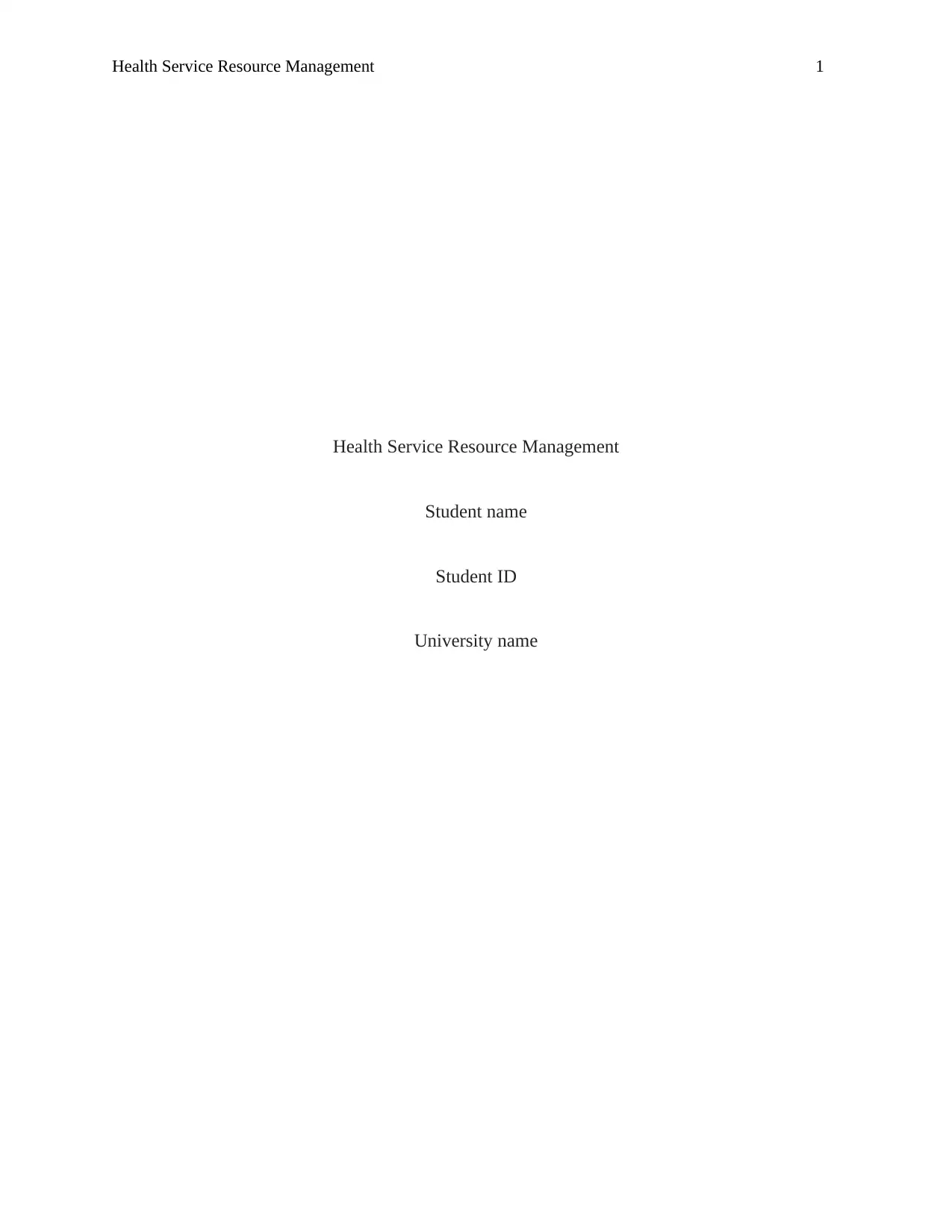
Health Service Resource Management 1
Health Service Resource Management
Student name
Student ID
University name
Health Service Resource Management
Student name
Student ID
University name
Paraphrase This Document
Need a fresh take? Get an instant paraphrase of this document with our AI Paraphraser
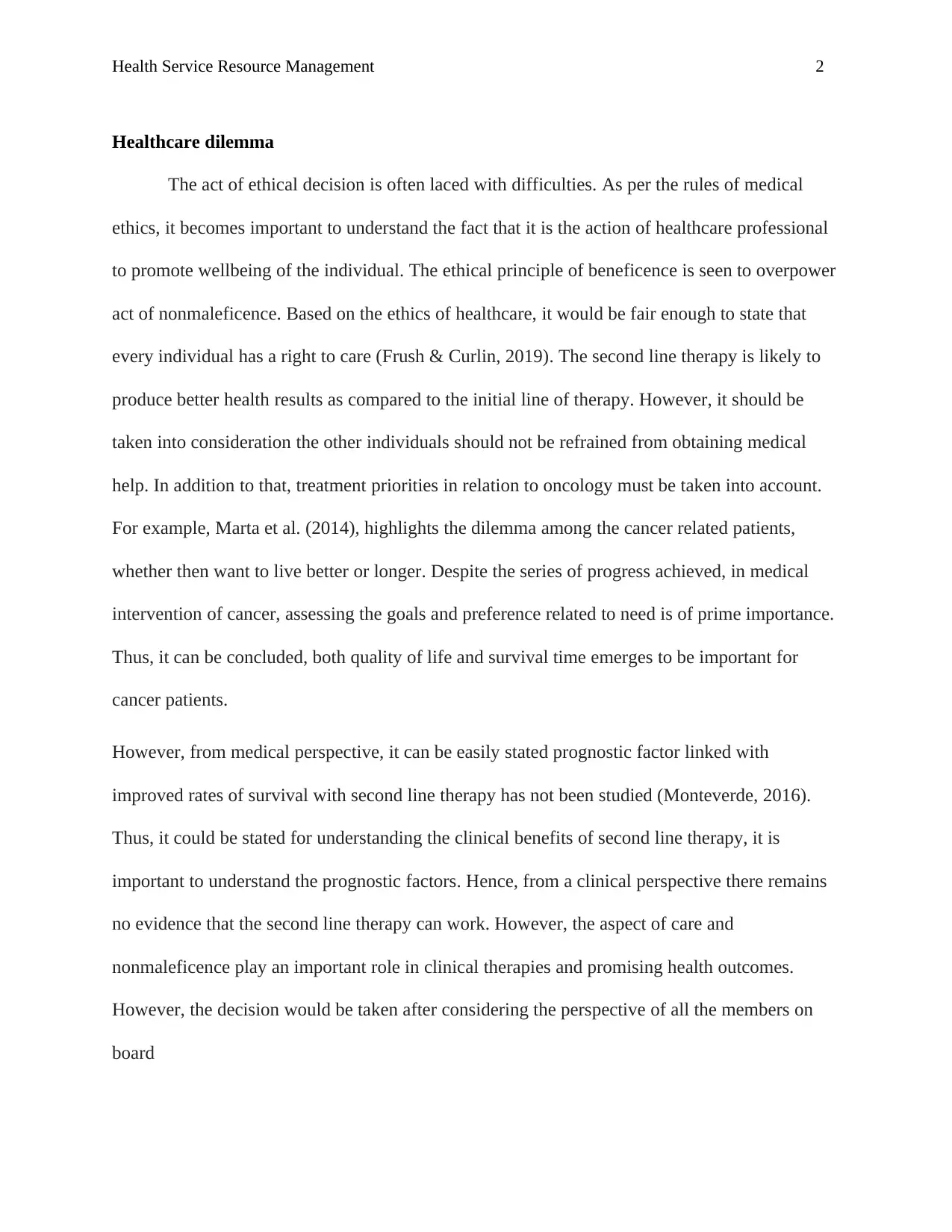
Health Service Resource Management 2
Healthcare dilemma
The act of ethical decision is often laced with difficulties. As per the rules of medical
ethics, it becomes important to understand the fact that it is the action of healthcare professional
to promote wellbeing of the individual. The ethical principle of beneficence is seen to overpower
act of nonmaleficence. Based on the ethics of healthcare, it would be fair enough to state that
every individual has a right to care (Frush & Curlin, 2019). The second line therapy is likely to
produce better health results as compared to the initial line of therapy. However, it should be
taken into consideration the other individuals should not be refrained from obtaining medical
help. In addition to that, treatment priorities in relation to oncology must be taken into account.
For example, Marta et al. (2014), highlights the dilemma among the cancer related patients,
whether then want to live better or longer. Despite the series of progress achieved, in medical
intervention of cancer, assessing the goals and preference related to need is of prime importance.
Thus, it can be concluded, both quality of life and survival time emerges to be important for
cancer patients.
However, from medical perspective, it can be easily stated prognostic factor linked with
improved rates of survival with second line therapy has not been studied (Monteverde, 2016).
Thus, it could be stated for understanding the clinical benefits of second line therapy, it is
important to understand the prognostic factors. Hence, from a clinical perspective there remains
no evidence that the second line therapy can work. However, the aspect of care and
nonmaleficence play an important role in clinical therapies and promising health outcomes.
However, the decision would be taken after considering the perspective of all the members on
board
Healthcare dilemma
The act of ethical decision is often laced with difficulties. As per the rules of medical
ethics, it becomes important to understand the fact that it is the action of healthcare professional
to promote wellbeing of the individual. The ethical principle of beneficence is seen to overpower
act of nonmaleficence. Based on the ethics of healthcare, it would be fair enough to state that
every individual has a right to care (Frush & Curlin, 2019). The second line therapy is likely to
produce better health results as compared to the initial line of therapy. However, it should be
taken into consideration the other individuals should not be refrained from obtaining medical
help. In addition to that, treatment priorities in relation to oncology must be taken into account.
For example, Marta et al. (2014), highlights the dilemma among the cancer related patients,
whether then want to live better or longer. Despite the series of progress achieved, in medical
intervention of cancer, assessing the goals and preference related to need is of prime importance.
Thus, it can be concluded, both quality of life and survival time emerges to be important for
cancer patients.
However, from medical perspective, it can be easily stated prognostic factor linked with
improved rates of survival with second line therapy has not been studied (Monteverde, 2016).
Thus, it could be stated for understanding the clinical benefits of second line therapy, it is
important to understand the prognostic factors. Hence, from a clinical perspective there remains
no evidence that the second line therapy can work. However, the aspect of care and
nonmaleficence play an important role in clinical therapies and promising health outcomes.
However, the decision would be taken after considering the perspective of all the members on
board
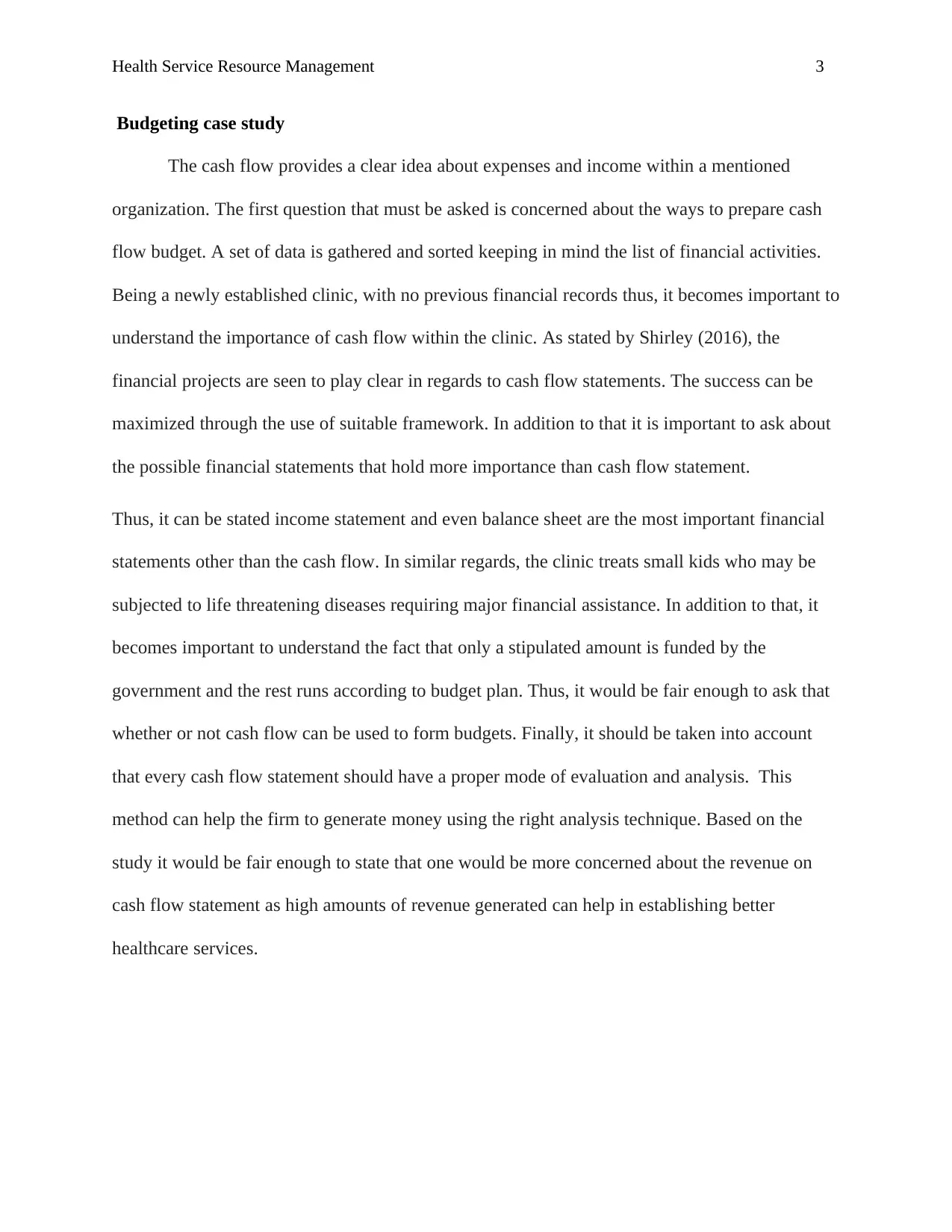
Health Service Resource Management 3
Budgeting case study
The cash flow provides a clear idea about expenses and income within a mentioned
organization. The first question that must be asked is concerned about the ways to prepare cash
flow budget. A set of data is gathered and sorted keeping in mind the list of financial activities.
Being a newly established clinic, with no previous financial records thus, it becomes important to
understand the importance of cash flow within the clinic. As stated by Shirley (2016), the
financial projects are seen to play clear in regards to cash flow statements. The success can be
maximized through the use of suitable framework. In addition to that it is important to ask about
the possible financial statements that hold more importance than cash flow statement.
Thus, it can be stated income statement and even balance sheet are the most important financial
statements other than the cash flow. In similar regards, the clinic treats small kids who may be
subjected to life threatening diseases requiring major financial assistance. In addition to that, it
becomes important to understand the fact that only a stipulated amount is funded by the
government and the rest runs according to budget plan. Thus, it would be fair enough to ask that
whether or not cash flow can be used to form budgets. Finally, it should be taken into account
that every cash flow statement should have a proper mode of evaluation and analysis. This
method can help the firm to generate money using the right analysis technique. Based on the
study it would be fair enough to state that one would be more concerned about the revenue on
cash flow statement as high amounts of revenue generated can help in establishing better
healthcare services.
Budgeting case study
The cash flow provides a clear idea about expenses and income within a mentioned
organization. The first question that must be asked is concerned about the ways to prepare cash
flow budget. A set of data is gathered and sorted keeping in mind the list of financial activities.
Being a newly established clinic, with no previous financial records thus, it becomes important to
understand the importance of cash flow within the clinic. As stated by Shirley (2016), the
financial projects are seen to play clear in regards to cash flow statements. The success can be
maximized through the use of suitable framework. In addition to that it is important to ask about
the possible financial statements that hold more importance than cash flow statement.
Thus, it can be stated income statement and even balance sheet are the most important financial
statements other than the cash flow. In similar regards, the clinic treats small kids who may be
subjected to life threatening diseases requiring major financial assistance. In addition to that, it
becomes important to understand the fact that only a stipulated amount is funded by the
government and the rest runs according to budget plan. Thus, it would be fair enough to ask that
whether or not cash flow can be used to form budgets. Finally, it should be taken into account
that every cash flow statement should have a proper mode of evaluation and analysis. This
method can help the firm to generate money using the right analysis technique. Based on the
study it would be fair enough to state that one would be more concerned about the revenue on
cash flow statement as high amounts of revenue generated can help in establishing better
healthcare services.
⊘ This is a preview!⊘
Do you want full access?
Subscribe today to unlock all pages.

Trusted by 1+ million students worldwide
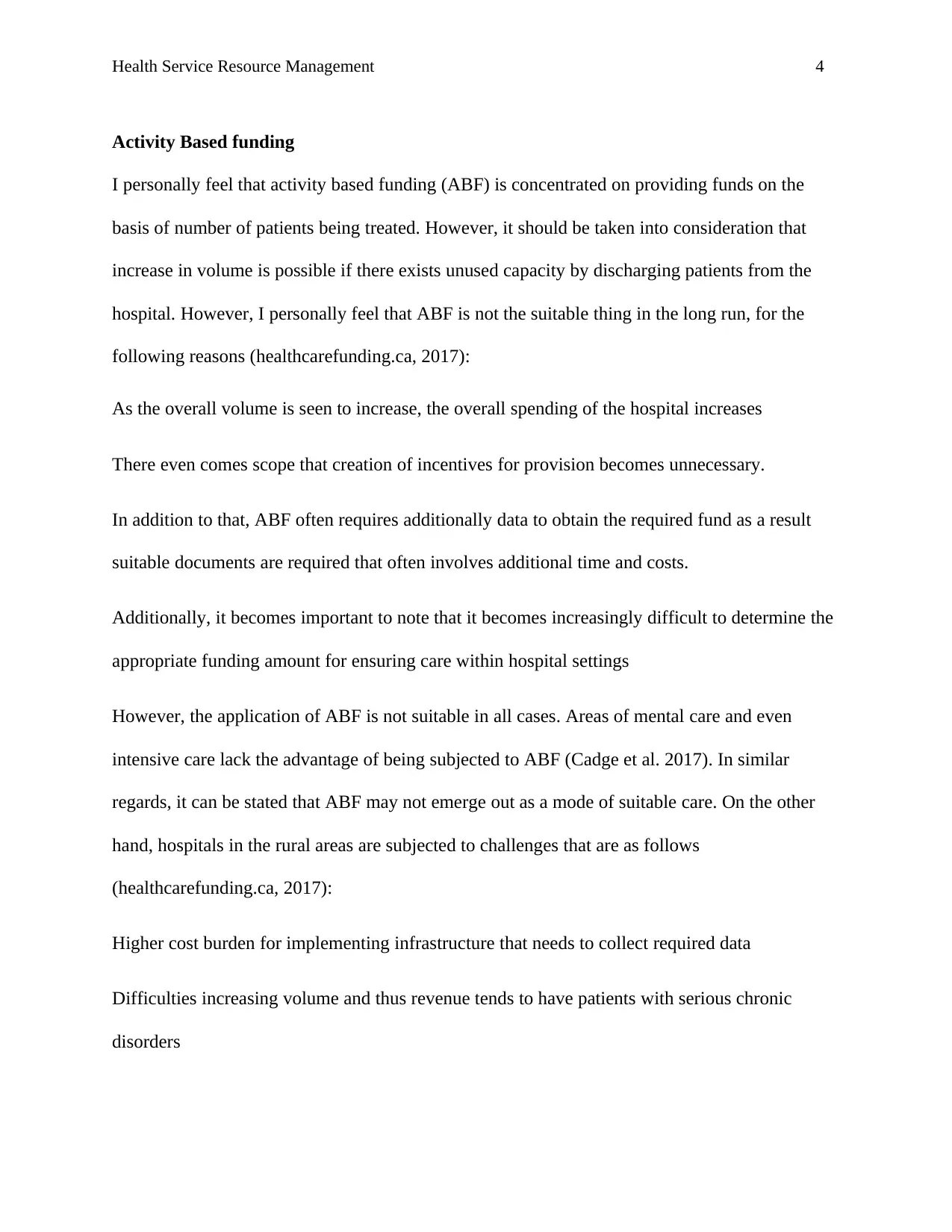
Health Service Resource Management 4
Activity Based funding
I personally feel that activity based funding (ABF) is concentrated on providing funds on the
basis of number of patients being treated. However, it should be taken into consideration that
increase in volume is possible if there exists unused capacity by discharging patients from the
hospital. However, I personally feel that ABF is not the suitable thing in the long run, for the
following reasons (healthcarefunding.ca, 2017):
As the overall volume is seen to increase, the overall spending of the hospital increases
There even comes scope that creation of incentives for provision becomes unnecessary.
In addition to that, ABF often requires additionally data to obtain the required fund as a result
suitable documents are required that often involves additional time and costs.
Additionally, it becomes important to note that it becomes increasingly difficult to determine the
appropriate funding amount for ensuring care within hospital settings
However, the application of ABF is not suitable in all cases. Areas of mental care and even
intensive care lack the advantage of being subjected to ABF (Cadge et al. 2017). In similar
regards, it can be stated that ABF may not emerge out as a mode of suitable care. On the other
hand, hospitals in the rural areas are subjected to challenges that are as follows
(healthcarefunding.ca, 2017):
Higher cost burden for implementing infrastructure that needs to collect required data
Difficulties increasing volume and thus revenue tends to have patients with serious chronic
disorders
Activity Based funding
I personally feel that activity based funding (ABF) is concentrated on providing funds on the
basis of number of patients being treated. However, it should be taken into consideration that
increase in volume is possible if there exists unused capacity by discharging patients from the
hospital. However, I personally feel that ABF is not the suitable thing in the long run, for the
following reasons (healthcarefunding.ca, 2017):
As the overall volume is seen to increase, the overall spending of the hospital increases
There even comes scope that creation of incentives for provision becomes unnecessary.
In addition to that, ABF often requires additionally data to obtain the required fund as a result
suitable documents are required that often involves additional time and costs.
Additionally, it becomes important to note that it becomes increasingly difficult to determine the
appropriate funding amount for ensuring care within hospital settings
However, the application of ABF is not suitable in all cases. Areas of mental care and even
intensive care lack the advantage of being subjected to ABF (Cadge et al. 2017). In similar
regards, it can be stated that ABF may not emerge out as a mode of suitable care. On the other
hand, hospitals in the rural areas are subjected to challenges that are as follows
(healthcarefunding.ca, 2017):
Higher cost burden for implementing infrastructure that needs to collect required data
Difficulties increasing volume and thus revenue tends to have patients with serious chronic
disorders
Paraphrase This Document
Need a fresh take? Get an instant paraphrase of this document with our AI Paraphraser
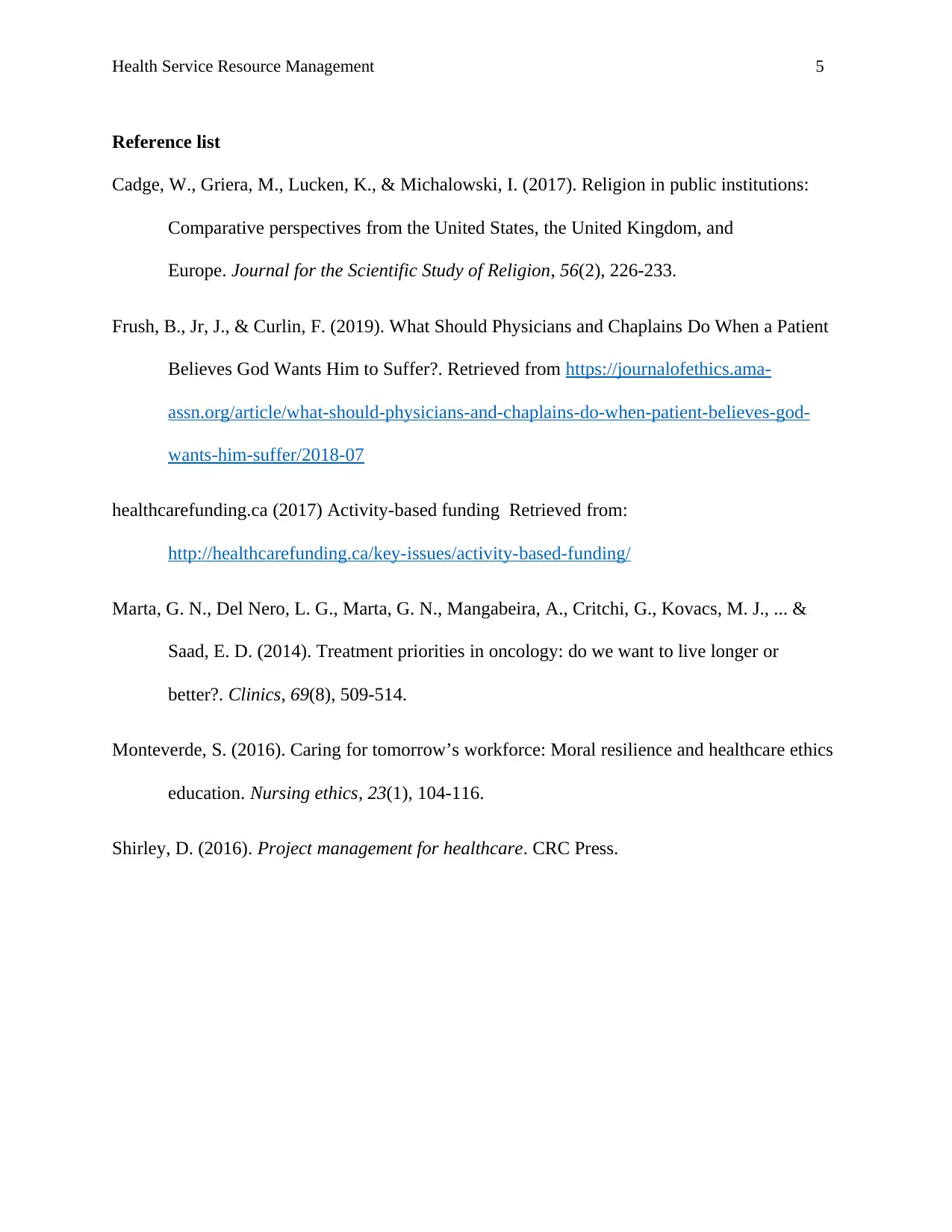
Health Service Resource Management 5
Reference list
Cadge, W., Griera, M., Lucken, K., & Michalowski, I. (2017). Religion in public institutions:
Comparative perspectives from the United States, the United Kingdom, and
Europe. Journal for the Scientific Study of Religion, 56(2), 226-233.
Frush, B., Jr, J., & Curlin, F. (2019). What Should Physicians and Chaplains Do When a Patient
Believes God Wants Him to Suffer?. Retrieved from https://journalofethics.ama-
assn.org/article/what-should-physicians-and-chaplains-do-when-patient-believes-god-
wants-him-suffer/2018-07
healthcarefunding.ca (2017) Activity-based funding Retrieved from:
http://healthcarefunding.ca/key-issues/activity-based-funding/
Marta, G. N., Del Nero, L. G., Marta, G. N., Mangabeira, A., Critchi, G., Kovacs, M. J., ... &
Saad, E. D. (2014). Treatment priorities in oncology: do we want to live longer or
better?. Clinics, 69(8), 509-514.
Monteverde, S. (2016). Caring for tomorrow’s workforce: Moral resilience and healthcare ethics
education. Nursing ethics, 23(1), 104-116.
Shirley, D. (2016). Project management for healthcare. CRC Press.
Reference list
Cadge, W., Griera, M., Lucken, K., & Michalowski, I. (2017). Religion in public institutions:
Comparative perspectives from the United States, the United Kingdom, and
Europe. Journal for the Scientific Study of Religion, 56(2), 226-233.
Frush, B., Jr, J., & Curlin, F. (2019). What Should Physicians and Chaplains Do When a Patient
Believes God Wants Him to Suffer?. Retrieved from https://journalofethics.ama-
assn.org/article/what-should-physicians-and-chaplains-do-when-patient-believes-god-
wants-him-suffer/2018-07
healthcarefunding.ca (2017) Activity-based funding Retrieved from:
http://healthcarefunding.ca/key-issues/activity-based-funding/
Marta, G. N., Del Nero, L. G., Marta, G. N., Mangabeira, A., Critchi, G., Kovacs, M. J., ... &
Saad, E. D. (2014). Treatment priorities in oncology: do we want to live longer or
better?. Clinics, 69(8), 509-514.
Monteverde, S. (2016). Caring for tomorrow’s workforce: Moral resilience and healthcare ethics
education. Nursing ethics, 23(1), 104-116.
Shirley, D. (2016). Project management for healthcare. CRC Press.
1 out of 5
Related Documents
Your All-in-One AI-Powered Toolkit for Academic Success.
+13062052269
info@desklib.com
Available 24*7 on WhatsApp / Email
![[object Object]](/_next/static/media/star-bottom.7253800d.svg)
Unlock your academic potential
Copyright © 2020–2025 A2Z Services. All Rights Reserved. Developed and managed by ZUCOL.





